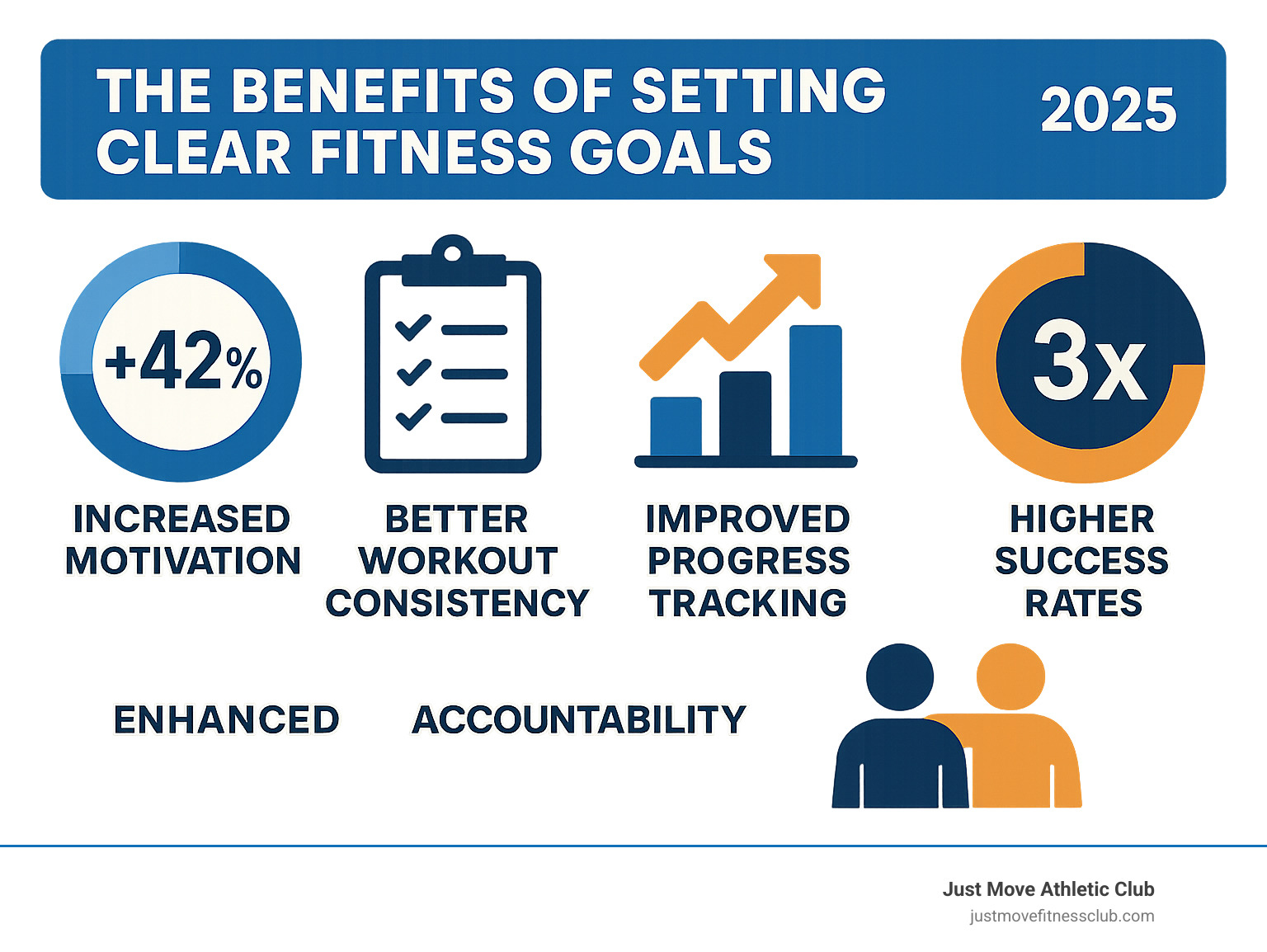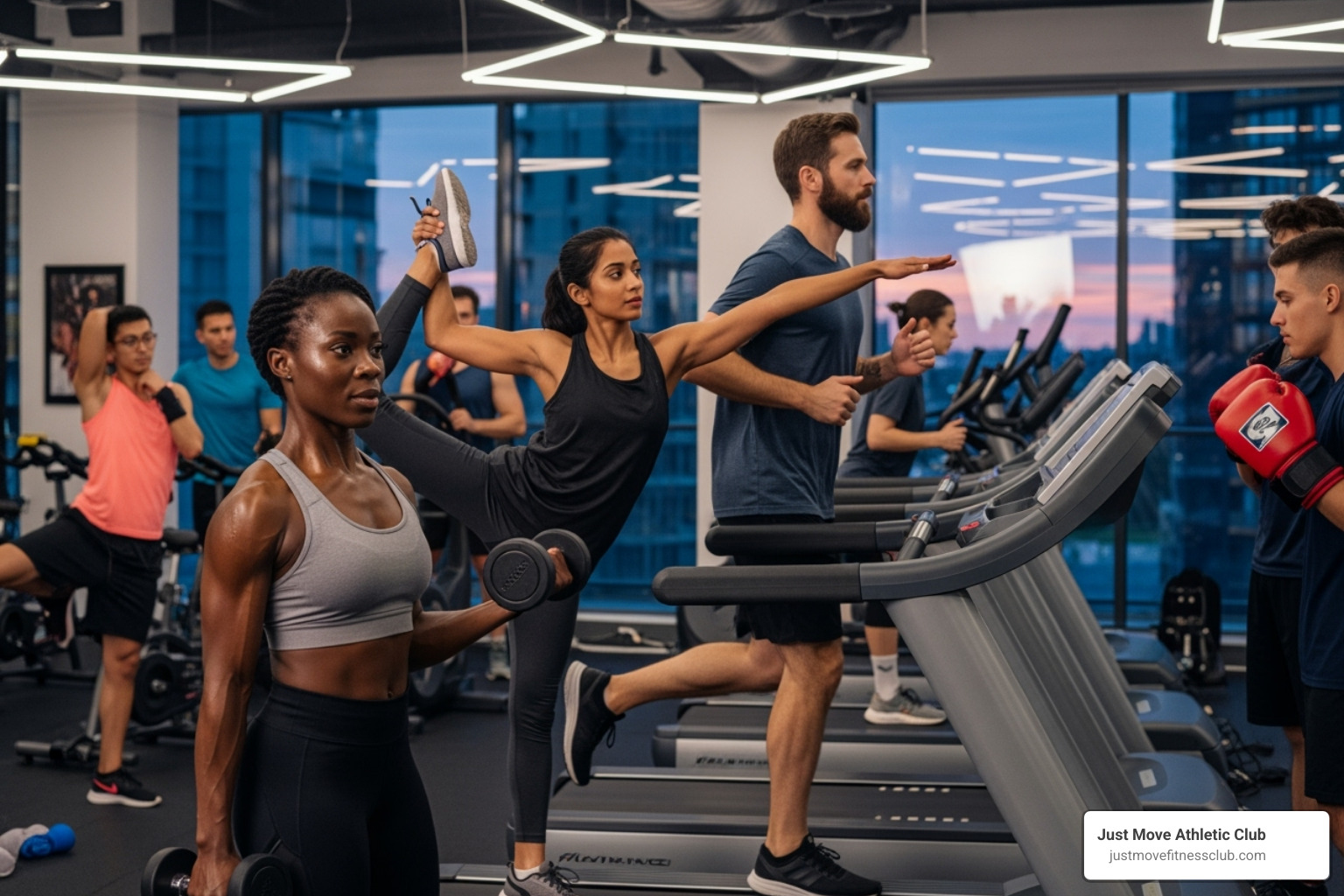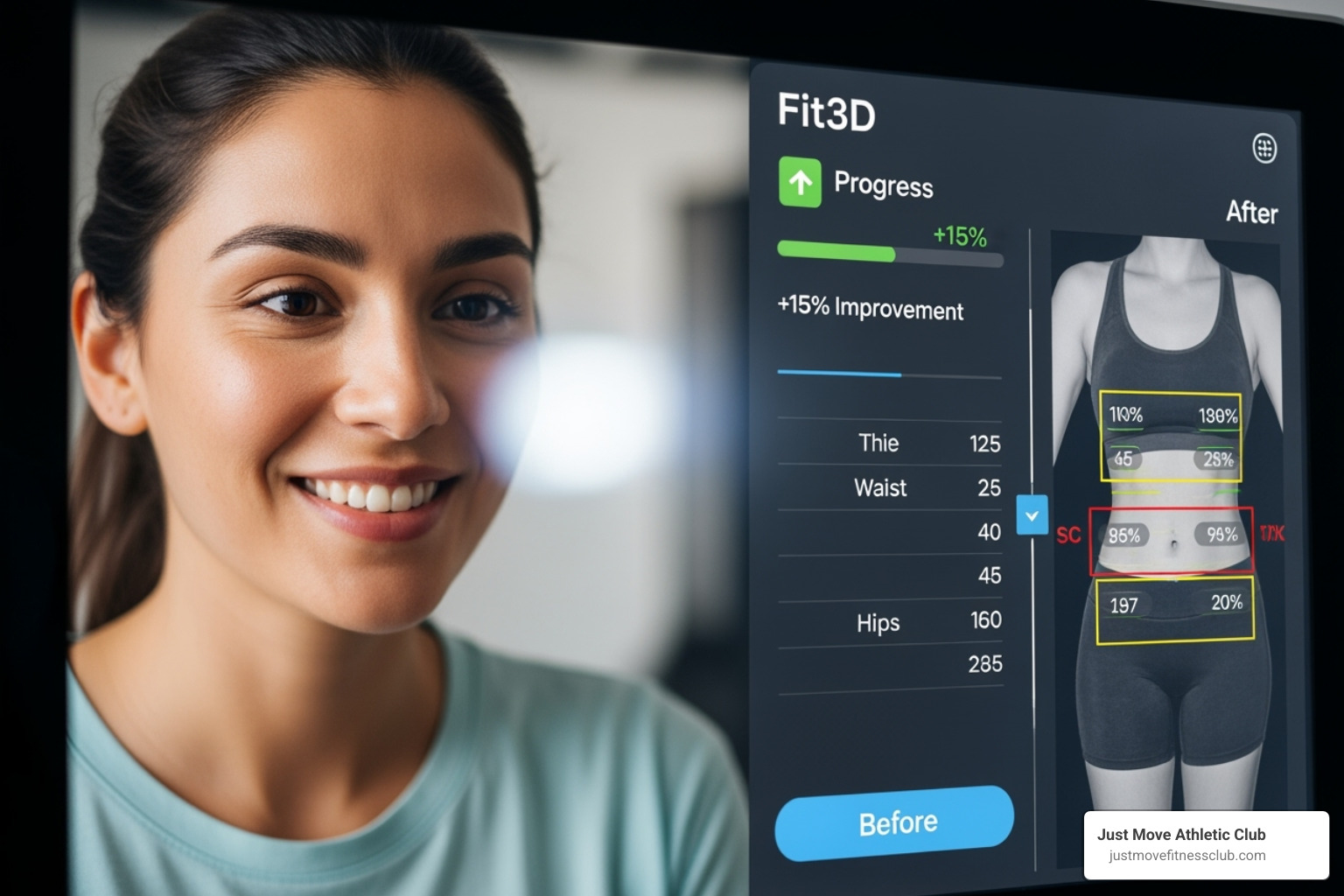Why Fitness Goal Setting Is Your Path to Success
Fitness goal setting is the process of identifying specific, achievable targets that guide your workout routine and create a clear path to better health. Here’s how to set effective fitness goals:
Quick Steps to Set Fitness Goals:
- Assess your current fitness level – Know where you’re starting from
- Use the SMART framework – Make goals Specific, Measurable, Attainable, Relevant, Time-bound
- Choose goal types – Set outcome goals (lose 10 pounds), process goals (work out 3x/week), and performance goals (run a 6-minute mile)
- Track your progress – Use journals, apps, or fitness assessments
- Stay flexible – Adjust goals as life changes
You’ve decided to improve your fitness – that’s a major step. But saying “I want to get in shape” isn’t enough. Research shows that people who set goals tend to exercise more, according to a Health Psychology Review study, than those who don’t. Without clear targets, it’s easy to lose motivation, skip workouts, or feel frustrated by lack of progress.
Fitness is not a destination but a journey, requiring dedication and perseverance. The difference between those who succeed and those who give up often comes down to having a clear roadmap. Goals give you that roadmap, helping you stay focused and motivated even when enthusiasm fades.
I’m Pleasant Lewis, and with over 40 years in the fitness industry, I’ve seen how proper fitness goal setting transforms lives and creates lasting results. I’ve helped thousands of people achieve their health objectives by focusing on realistic, personalized goal-setting strategies.

Why Clear Fitness Goals Are Your First Step to Success
Setting clear fitness goals is not just a formality; it’s a powerful catalyst for change and sustained progress. It’s the difference between wandering aimlessly and navigating with purpose.
One of the most significant benefits is a direct motivation boost. When we know precisely what we’re working towards, our efforts become more intentional and our resolve strengthens. Research consistently shows that taking the time to set a goal helps people start and stick to all sorts of healthy behaviors. This clarity translates into better workout efficiency, as each session can be custom to move us closer to our objectives.
Moreover, clearly defined goals foster increased accountability. Whether it’s to ourselves, a workout buddy, or a personal trainer, having a tangible target makes us more likely to show up and put in the work. This consistent effort is crucial for building healthy habits that extend beyond the gym, impacting overall lifestyle choices. Achieving these goals provides an immense sense of accomplishment, fueling further progress and reinforcing positive behaviors.
The Psychological Edge
Goals provide a crucial psychological edge. They offer a sense of empowerment and control over our fitness journey. Instead of feeling overwhelmed by the vastness of “getting fit,” we focus on manageable steps. This focus helps us in overcoming obstacles; when we encounter challenges, our clear goal reminds us of our “why,” helping us push through. Goals cultivate focus and discipline, guiding our actions even on days when motivation is low. It’s about translating desire into results, systematically working towards a vision. This process creates a positive feedback loop: as we achieve small milestones, our confidence grows, making us more likely to pursue even bigger goals.
Health and Wellness Benefits
Beyond motivation, the consistent effort driven by clear goals yields significant health and wellness benefits. Regular physical activity, guided by specific objectives, leads to improved cardiovascular health, reducing the risk of heart disease and type 2 diabetes. We also see increased muscle mass and a reduction in body fat, contributing to a healthier body composition. Weight-bearing exercise, often part of fitness goals, helps improve bone density, protecting against fractures as we age. For a comprehensive look at the advantages, the Centers for Disease Control and Prevention highlights the many benefits of regular exercise. Furthermore, the discipline and sense of achievement gained through fitness goal setting profoundly impacts improved mental well-being, reducing stress and anxiety.
Before You Set Goals: Assess Your Starting Point
Before we dive headfirst into setting ambitious goals, it’s crucial to take a moment for honest self-assessment. Understanding our current fitness level is like checking the weather before planning a hike – it tells us what to expect and how to prepare. This honesty about current fitness allows us to establish a baseline, a starting point from which all progress will be measured. It also helps in understanding limitations, ensuring that our goals are realistic and safe, and plays a vital role in preventing injury. We can’t celebrate how far we’ve come if we don’t know where we started!

How to Assess Your Current Fitness Level
To set appropriate goals, we need to know what our body can currently do. Here are key areas to assess:
- Aerobic Fitness (Mile Walk Test): This measures your cardiovascular endurance. We can assess this by recording our pulse rate before and after walking a mile, and noting the time it takes to complete the mile.
- Muscular Strength (Push-Up Test): This helps gauge upper body and core strength. We can determine how many push-ups we can perform with good form.
- Flexibility (Sit-and-Reach): This assesses the flexibility of our lower back and hamstrings. A seated reach distance can give us a good indication.
- Body Composition: This looks at the proportion of fat and fat-free mass in our body. We can use measurements like our waist circumference (just above the hipbones) and calculate our body mass index (BMI), which compares our weight to our height.
Recording these baseline scores will be invaluable for tracking our progress down the line. A health or fitness professional can help us learn how to get these scores accurately.
The Importance of Professional Guidance
While self-assessment is a great start, professional guidance can be a game-changer, especially for certain individuals. If we have a chronic medical condition, such as diabetes or heart disease, it is absolutely essential to consult a healthcare professional before beginning any new exercise program. They can advise us on safe and appropriate activities, ensuring our fitness journey supports our overall health. The pre-exercise self-screening tool can help determine if a medical consultation is necessary.
For healthy adults planning small increases in physical activity, consulting a professional isn’t always needed. However, working with a personal trainer or exercise physiologist can provide expert insights, personalized plans, and accountability. They can help us in setting safe and effective goals that are custom to our individual needs and aspirations, maximizing our potential while minimizing risks.
The SMART Framework for Fitness Goal Setting
“I want to get in shape” is a noble thought, but it’s not a goal. It’s a wish. To transform wishes into achievements, we employ the SMART goal-setting framework. This method provides an actionable plan, helping us avoid frustration and setting us up for success. Indeed, the key to succeeding in our fitness goals is devising them with the SMART method in mind.

S: Making Your Fitness Goal Setting Specific
A specific goal clearly defines what we want to achieve. It answers the “who, what, where, when, why” of our objective. Instead of saying “I will get stronger,” a specific goal would be: “I will do strength training 3 times per week, focusing on major muscle groups, to increase my overall strength and muscular endurance.” This clarity over vagueness provides a precise target, making it easier to plan and execute.
M: Making Your Goals Measurable
Measurable goals allow us to track our progress and know when we’ve succeeded. They involve quantifiable targets. For example, instead of “I want to run more,” a measurable goal is: “I will run 1 mile continuously without stopping in 6 weeks.” Or, if weight loss is the aim: “I will lose 10 pounds in 3 months.” Using numbers helps us stay motivated by clearly showing how far we’ve come and how much more we need to do.
A: Ensuring Your Goals Are Attainable
Attainable goals are realistic and achievable given our current circumstances and abilities. This isn’t about setting easy goals, but about setting challenging ones that are still within reach. If we haven’t exercised in years, aiming to run a marathon next month isn’t attainable. A more realistic goal might be to “complete a 5K race in 3 months.” Starting small and building confidence through achievable milestones prevents burnout and ensures we keep moving forward. A good rule of thumb for weight loss is to aim for a healthy and sustainable 1-2 pounds per week.
R: Keeping Your Fitness Goal Setting Relevant
Relevant goals align with our personal values, overall health objectives, and lifestyle. They answer the question: “Why is this goal important to me?” If we hate running, setting a goal to run a marathon might not be relevant to our interests, leading to quick loss of motivation. Instead, choose activities we enjoy. As the research shows, we are more likely to continue a fitness program we enjoy. Our goals should tap into our “why,” whether it’s to improve cardiovascular health, improve strength and flexibility, or simply feel more energetic. This ensures we are enjoying the process and that our efforts genuinely contribute to our desired quality of life.
T: Making Your Goals Time-Bound
A time-bound goal has a specific deadline, creating a sense of urgency and preventing procrastination. “I will complete a 5K race in 3 months” is time-bound. Without a deadline, it’s easy to push our goals aside indefinitely. Time-bound goals can be short-term (1-3 months) or long-term (6-12+ months), but each should have a clear endpoint. This structure helps us plan our steps and stay accountable.
Building Your Blueprint: Goal Types and Examples
Once we understand the SMART framework, we can apply it to different types of fitness goals. It’s important to create a balanced plan that includes a mix of objectives, leading to both short-term wins and a clear long-term vision.

Outcome, Process, and Performance Goals
Not all goals are created equal, and understanding the different types can help us build a more comprehensive and sustainable plan.
| Goal Type | Focus | Example |
|---|---|---|
| Outcome Goals | The ‘what’ – the final result or destination. These are the most common. | Lose 20 pounds; Fit into old jeans; Win a competition. |
| Process Goals | The ‘how’ – the actions and steps taken to achieve an outcome. These are within our direct control. | Go to the gym 4 times a week; Drink 2 liters of water daily; Prepare healthy meals 5 days a week. |
| Performance Goals | The ‘better’ – improving one’s own skill or performance in a specific area, regardless of others’ results. | Decrease mile time by 30 seconds; Perform 20 push-ups without breaks; Lift 10% more weight in an exercise. |
While outcome goals are motivating, focusing too much on them can be discouraging if progress isn’t linear. Process and performance goals, however, give us control and celebrate the effort and skill development along the way. Habit goals, such as “work out 3 times a week,” are often more sensible than solely focusing on a number on the scale, as the latter doesn’t account for muscle gain or other body changes.
Short-Term Goal Examples (1-3 Months)
Short-term goals are our immediate stepping stones. They provide quick wins and build momentum.
- Average 7,500 steps a day for a month: While 10,000 steps is often cited, research in JAMA Internal Medicine suggests the benefits of taking more steps daily level off at about 7,500. This is a very attainable and impactful goal.
- Hold a 1-minute plank: Start with 20-30 seconds and increase by five-second increments. A strong core maintains proper posture, which reduces back pain and other injuries.
- Stretch for 10 minutes after each workout: Hold each stretch for 15-45 seconds. Building flexibility improves range of motion and can prevent injury.
- Try a new group fitness class each week for a month: This helps us find activities we truly enjoy, increasing adherence.
- Drink 2-3 liters of water daily for a month: Proper hydration is crucial for energy, performance, and overall health.
Long-Term Goal Examples (6-12+ Months)
Long-term goals are our ultimate destinations, requiring sustained effort and often building upon several short-term achievements.
- Run a half-marathon: This is a significant endurance goal that requires consistent training over several months.
- Complete an obstacle course race or triathlon: These challenge multiple aspects of fitness – strength, endurance, and mental grit.
- Build a specific amount of muscle: For example, increase bench press by 50% within six months. Progressive overload, strategically increasing stress on muscles, is key here.
- Hike a challenging trail: This combines cardiovascular endurance with strength and often balance, offering a rewarding outdoor experience.
- Achieve a consistent workout streak for a year: This focuses on habit formation and dedication, demonstrating true consistency.
Staying on Track: Motivation, Monitoring, and Adapting
Setting goals is only half the battle; the real work lies in staying committed and navigating the inevitable ups and downs. Consistency is key for building exercise habits and seeing results. We must learn to overcome plateaus, celebrate milestones, and practice self-compassion.

How to Monitor Progress and Stay Motivated
Monitoring our progress is vital for staying motivated. It allows us to see how far we’ve come and adjust our plan as needed.
- Fitness journals: Keeping an exercise journal where we note daily activity, weights lifted, distances covered, or reps completed can provide a clear record of our journey.
- Tracking apps: Many apps can log workouts, steps, calories, and even sleep, offering convenient data visualization.
- Progress photos: Visual changes can be incredibly motivating. Taking photos regularly allows us to see changes that the scale might not capture.
- Using technology like 3D body scanners: Some fitness centers offer comprehensive, 3D body scans that measure body composition, circumference measurements, and posture analysis. This state-of-the-art technology provides incredibly accurate and motivating data to track progress beyond just weight.
- Finding a workout buddy: Accountability partners can provide encouragement and make workouts more enjoyable.
- Creating a reward system: Small, non-food rewards for hitting milestones can keep motivation high. This could be new workout gear, a massage, or a fun outing.
Common Pitfalls and How to Avoid Them
Even with the best intentions, we can stumble. Being aware of common pitfalls helps us avoid them.
- Setting unrealistic goals: This quickly leads to burnout and disappointment. Remember to make goals attainable.
- Focusing only on the scale: Weight fluctuates due to many factors (hydration, muscle gain). It’s a poor sole indicator of progress. Focus on how our clothes fit, strength gains, or how we feel.
- All-or-nothing mindset: Missing one workout doesn’t mean the whole plan is ruined. We should avoid the trap of thinking we’ve failed and giving up entirely.
- Fearing setbacks: Life happens. Injuries, illnesses, or busy periods are normal. What matters is how we respond.
- Not enjoying the activity: If we dread every workout, consistency will be a struggle. Find activities that bring us joy.
Adapting Your Plan When Life Happens
Life is unpredictable, and our fitness plans need to be flexible. If circumstances change, such as illness, injury, or travel, we need strategies to adapt.
- Flexibility: Instead of rigidly sticking to a plan, be prepared to modify it. If we can’t make it to the gym, perhaps a home workout or a brisk walk is possible.
- Adjusting timelines for illness or vacation: It’s okay to pause or reduce intensity. Rest is crucial for recovery. We can pick up where we left off or slightly adjust our long-term goal’s timeline.
- Reassessing goals: If a goal seems out of reach or no longer aligns with our current life, it’s perfectly fine to reassess and adjust it. Our goals should serve us, not the other way around.
- Focusing on what you can control: During challenging times, we might not control our workout volume, but we can control our nutrition or hydration.
- Being gentle with yourself: Don’t berate yourself if you fall short. Thank your body for what it has helped you accomplish, and gently guide yourself back on track. The first few months of a new exercise program are always the most challenging.
Conclusion
Fitness goal setting is more than just a trend; it’s our essential roadmap to success in health and wellness. By setting clear, intentional goals, we empower ourselves with motivation, focus, and a tangible way to measure progress.
We’ve learned to start with assessment, understanding our current fitness level and seeking professional guidance when needed. We’ve mastered the SMART framework – ensuring our goals are Specific, Measurable, Attainable, Relevant, and Time-bound – changing vague aspirations into actionable plans. We’ve explored diverse goal types, from short-term wins to long-term visions, creating a comprehensive blueprint for our fitness journey. And most importantly, we’ve equipped ourselves with strategies to track our progress and adapt our plans when life inevitably throws us a curveball, embracing consistency and self-compassion.
At Just Move Athletic Club, we are passionate about providing the tools and support you need to achieve your fitness aspirations. With resources like personalized training and advanced progress tracking, we are here to guide you every step of the way.
